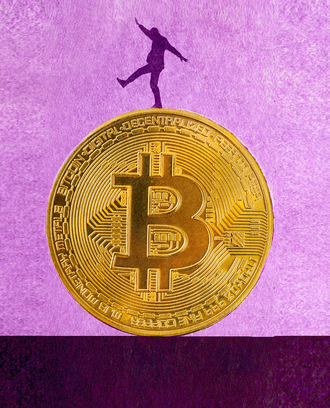What is a blockchain?
Blockchain is a term widely used to represent an entire new suite of technologies. There is substantial confusion around its definition because the technology is early-stage, and can be implemented in many ways depending on the objective.
“At a high level, blockchain technology allows a network of computers to agree at regular intervals on the true state of a distributed ledger,” says MIT Sloan assistant professor Christian Catalini, an expert in blockchain technologies and cryptocurrency. “Such ledgers can contain different types of shared data, such as transaction records, attributes of transactions, credentials, or other pieces of information. The ledger is often secured through a clever mix of cryptography and game theory, and does not require trusted nodes like traditional networks. This is what allows bitcoin to transfer value across the globe without resorting to traditional intermediaries such as banks.”
On a blockchain, transactions are recorded chronologically, forming an immutable chain, and can be more or less private or anonymous depending on how the technology is implemented. The ledger is distributed across many participants in the network — it doesn’t exist in one place. Instead, copies exist and are simultaneously updated with every fully participating node in the ecosystem. A block could represent transactions and data of many types — currency, digital rights, intellectual property, identity, or property titles, to name a few.
“The technology is particularly useful when you combine a distributed ledger together with a cryptotoken,” Catalini says. “Suddenly you can bootstrap an entire network that can achieve internet-level consensus about the state and authenticity of a block’s contents in a decentralized way. Every node that participates in the network can verify the true state of the ledger and transact on it at a very low cost. This is one step away from a distributed marketplace, and will enable new types of digital platforms.”
How is blockchain related to bitcoin?
Bitcoin, with a market cap of more than $40 billion, is the largest implementation of blockchain technology to date. While a lot of media attention has shifted from bitcoin to blockchain, the two are intertwined.
“When The Economist put blockchain on the cover in 2015, it wasn’t really about its use to support a digital currency anymore. It was all about the other applications this technology will unleash within the next 5 to 10 years,” Catalini says. “For example, in finance and accounting there is excitement about the ability to settle and reconcile global transactions at a lower cost using the technology. In logistics the attention is all on how you can use the immutable audit trail generated by a blockchain to improve the tracking of goods through the economy. Others are fascinated by the possibility to use this as a better identity and authentication system.”
There are two types of costs blockchain could reduce for you: the cost of verification and the cost of networking.
So what’s the big deal? In a recent paper, Catalini explains why business leaders should be excited about blockchain — it can save them money and could upend how business is conducted.
Every business and organization engages in many types of transactions every day. Each of those transactions requires verification. In many cases, that verification is easy. You know your customers, your clients, your colleagues, and your business partners. Having worked with them and their products, data, or information, you have a pretty good idea of their value and trustworthiness.
“But every so often, there’s a problem, and when a problem arises, we often have to perform some sort of audit,” Catalini says. “It could be actual auditors coming into a firm. But in many other cases, you’re running some sort of process to make sure the person claiming to have those credentials did have those credentials, or the firm selling you the goods did have the certification. When we do that, it’s a costly, labor-intensive process for society. The marketplace slows down and you have to incur additional costs to match demand and supply.”
“The reason distributed ledgers become so useful in these cases is because if you recorded those attributes you now need to verify securely on a blockchain, you can always go back and refer back to them at no cost,” he says. “It’s costless verification. So when you think about why bitcoin works, it’s because it can cheaply verify that the funds are actually there. You can transfer value from here to anywhere on the globe at almost zero transaction cost. Sending secure messages that carry value does not require a bank or PayPal in the middle anymore.”
In short: Because the blockchain verifies trustworthiness, you don’t have to. And the friction of the transaction is reduced, resulting in cost and time savings.
Using a blockchain can also reduce the cost of running a secure network. This will happen over a longer timeline, Catalini says, perhaps a decade. The internet has already allowed for a faster, less stilted exchange of goods and services. But it still needs intermediaries, however efficient they may be — think eBay, Airbnb, and Uber.
“Those intermediaries are costly and earn rents for processing payments, maintaining a reputation system, matching demand and supply,” Catalini says. “This is where blockchain technology, combined with a cryptotoken, allows you to rethink an entire value chain from the ground up. That’s where incumbents should be slightly worried, because in the long run the way you may be delivering value to your customers and competing against other companies could be fundamentally different.”
Blockchain technology could mean greater privacy and security for you and your customers.
Catalini calls it data leakage. When you give a bartender your driver’s license, all that person needs to know is your age. But you’re revealing so much more — your address, your height, whether you’re an organ donor, etc.
The same thing happens in commercial transactions.
“As your business partner, I need to know that you’re trustworthy and reliable, but for simple transactions I don’t really need to know many other things about you,” Catalini says. “Information disclosure is increasingly becoming a cost because of data breaches. We can’t keep our data private and it’s becoming increasingly complex to do so within large organizations. So imagine a model where you can verify certain attributes are true or false, potentially using a decentralized infrastructure, but you don’t have to reveal all these attributes all the time.”
In a business transaction context, Catalini says, a blockchain could be used to build a reputation score for a party, who could then be verified as trustworthy or solvent without having to open its books for a full audit.
“Reputation scores both for businesses and individuals are today siloed into different platforms, and there is very little portability across platforms. Blockchain can improve on this,” he says.
Which industries could blockchain disrupt?
“All of them,” Catalini says. “The technology is what economists call a general purpose technology, and we will see many applications across different verticals.”
Here are a few to keep an eye on.
Central banks: Many central banks — including those in Canada, Singapore, and England — are studying and experimenting with blockchain technology and cryptocurrencies. The potential applications include lower settlement risk, more efficient taxation, faster cross-border payments, inter-bank payments, and novel approaches to quantitative easing. Imagine a central bank stimulating the economy by delivering digital currency automatically to citizens. Don’t expect big moves from big countries soon. The risk is too high, Catalini says. But expect to see smaller, developed countries with a high tolerance for technology experimentation lead the way and possibly experiment with a fiat-backed, digital currency for some of their needs.
Finance: The busiest area of application so far, blockchain is being used by companies seeking to offer low cost, secure, verifiable international payments and settlement. Ripple is one of the leaders in this space on the banking side. Meanwhile, companies like Digital Asset and Chain seek to create a faster, more efficient financial infrastructure for tracking and exchanging financial assets of any type.
Money transfer: In 2014, two MIT students raised and distributed $100 worth of bitcoin to every MIT undergraduate. They wanted to see what would happen and generate interest on campus. Catalini, together with professor Catherine Tucker, designed the experiment and studied the results. While 11 percent immediately cashed out their bitcoin, 49 percent were still holding on to some bitcoin. Some students used the funds to make purchases at local merchants, some of whom accepted bitcoin. Others traded with each other. Meanwhile, startups around the world competed to become the consumer trading application for bitcoin. Then PayPal bought Venmo, a payment platform that trades cash. PayPal’s own mobile app allows for peer-to-peer transactions, as well. The bitcoin-based consumer payment industry cooled down. But the application of blockchain remains attractive because of the lower costs it could offer parties in global, peer-to-peer transactions. Rapid payment company Circle, which advertises itself as “Like a text filled with cash,” stopped allowing users to exchange bitcoin last year, but is building a protocol that allows digital wallets to exchange value using a blockchain.
Web browser company Brave uses a blockchain to verify when users have viewed ads and, in turn, pays publishers when those same users consume content.
Web browser company Brave uses a blockchain to verify when users have viewed ads and, in turn, pays publishers when those same users consume content.
Micropayments: What if, instead of subscribing to a news site online, you paid only for the articles you read? As you click through the web, your browser would track the pages and record them for payment. Or what if you could get small payments for doing work — completing surveys, working as a freelance copy editor — for a variety of clients.
By reducing the cost of the transaction and verifying the legitimacy of parties on either end, blockchain could make these micropayments, new types of cross-platform subscriptions, and forms of crowdsourcing possible and practical.
A company called Brave is already attempting this, with potential ramifications for the digital advertising industry.
Identity and privacy: In October 2013, the arrest of the founder of Silk Road, a deep web marketplace where users paid for illegal goods with bitcoin, showed just how anonymous bitcoin really wasn’t. Nor was it ever intended to be — bitcoin addresses function much as a pseudonym does for a writer, Catalini says. Users can never completely mask their transactions. But others are trying. Zcash promises to be a fully private cryptocurrency. There are significant downsides to the anonymity a blockchain could offer, such as the ability to fund terrorism or facilitate money laundering. But there are many virtuous applications too — Google’s DeepMind is attempting to use blockchain to layer privacy and security in electronic health care records.
Smart contracts: This application is still in the early stages, Catalini says, but by recording information on a blockchain, contracts could use that information to make themselves self-executing if certain conditions are met. This idea backfired last year when code was exploited to steal $60 million from The DAO, a blockchain-based venture capital firm.
Provenance and ownership: A blockchain could be used to record details about physical products, helping to verify authenticity and prevent fraud and counterfeiting. London-based EverLedger is tracking diamonds and envisions doing the same for fine wines. At the same time, for all these applications, a blockchain is only as useful as the quality of the information recorded on it in the first place.
Internet of things, robotics, and artificial intelligence: Your appliances are already talking to each other — think smart home technologies like Nest thermostats and security systems. What if they could barter or acquire resources? What if a highway could verify the identity of and accept payment from a self-driving car, opening up a pay-per-use fast lane to commuters in a rush? At the outer edge of application, but not outside the realm of possibility, Catalini says.
When will this disruption happen?
Over a period of more than ten years. Catalini is convinced blockchain has internet-level disruption potential, but like the internet it will come over a multi-decade timeline with fits and starts, and occasional setbacks. Some industries, especially finance, will see drastic change soon. Others will take longer.
“A lot of the work in this space is experimental,” Catalini says. “We are at the infrastructure building stage. Bitcoin has a market capitalization of $42 billion, which is nothing compared to the mainstream financial platforms and exchanges that move trillions of dollars every day. But the technology is maturing and growing. At some point, one of the startups in this space may reveal itself to be the Netscape of cryptocurrencies. What would follow is something we have seen play out many times before in history.”
Ready to go deeper?
New research, writing, and videos from Catalini and other MIT Sloan faculty members is available at blockchain.mit.edu. Sign up there to receive updates with the latest and most important MIT work about blockchain.
The expert
Christian Catalini is the Fred Kayne (1960) Career Development Professor of Entrepreneurship, and Assistant Professor of Technological Innovation, Entrepreneurship, and Strategic Management at MIT Sloan. He is an expert in blockchain technology and cryptocurrencies, equity crowdfunding, the adoption of technology standards, and science and technology interactions. He is one of the principal investigators of the MIT Digital Currency Study, which gave all MIT undergraduate students access to bitcoin in Fall 2014. He is also part of the MIT Initiative on the Digital Economy. His work has been featured in Nature, the New York Times, the Wall Street Journal, the Economist, WIRED, NPR, Forbes, Bloomberg, the Chicago Tribune, the Boston Globe, and VICE News, among others.
Read next — Bitcoin: Who owns it, who mines it, who’s breaking the law



